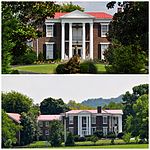William Martin House (Brentwood, Tennessee)
Colonial Revival architecture in TennesseeHouses completed in 1850Houses in Williamson County, TennesseeHouses on the National Register of Historic Places in TennesseeNational Register of Historic Places in Williamson County, Tennessee ... and 1 more
Williamson County, Tennessee Registered Historic Place stubs

The William Martin House is a building and property in Brentwood, Tennessee, United States, that dates from c. 1910 and was listed on the National Register of Historic Places (NRHP) in 1988. It has also been known as Boxwood Hall. It is a two-story house that was built c. 1850 but was extensively remodeled into Colonial Revival style in c. 1910. The NRHP listing was for two contributing buildings on an area of 1.7 acres (0.69 ha). The NRHP eligibility of the property was covered in a 1988 study of Williamson County historical resources.
Excerpt from the Wikipedia article William Martin House (Brentwood, Tennessee) (License: CC BY-SA 3.0, Authors, Images).William Martin House (Brentwood, Tennessee)
Seward Road,
Geographical coordinates (GPS) Address Nearby Places Show on map
Geographical coordinates (GPS)
| Latitude | Longitude |
|---|---|
| N 36.026111111111 ° | E -86.806388888889 ° |
Address
Seward Road 5259
37027
Tennessee, United States
Open on Google Maps





